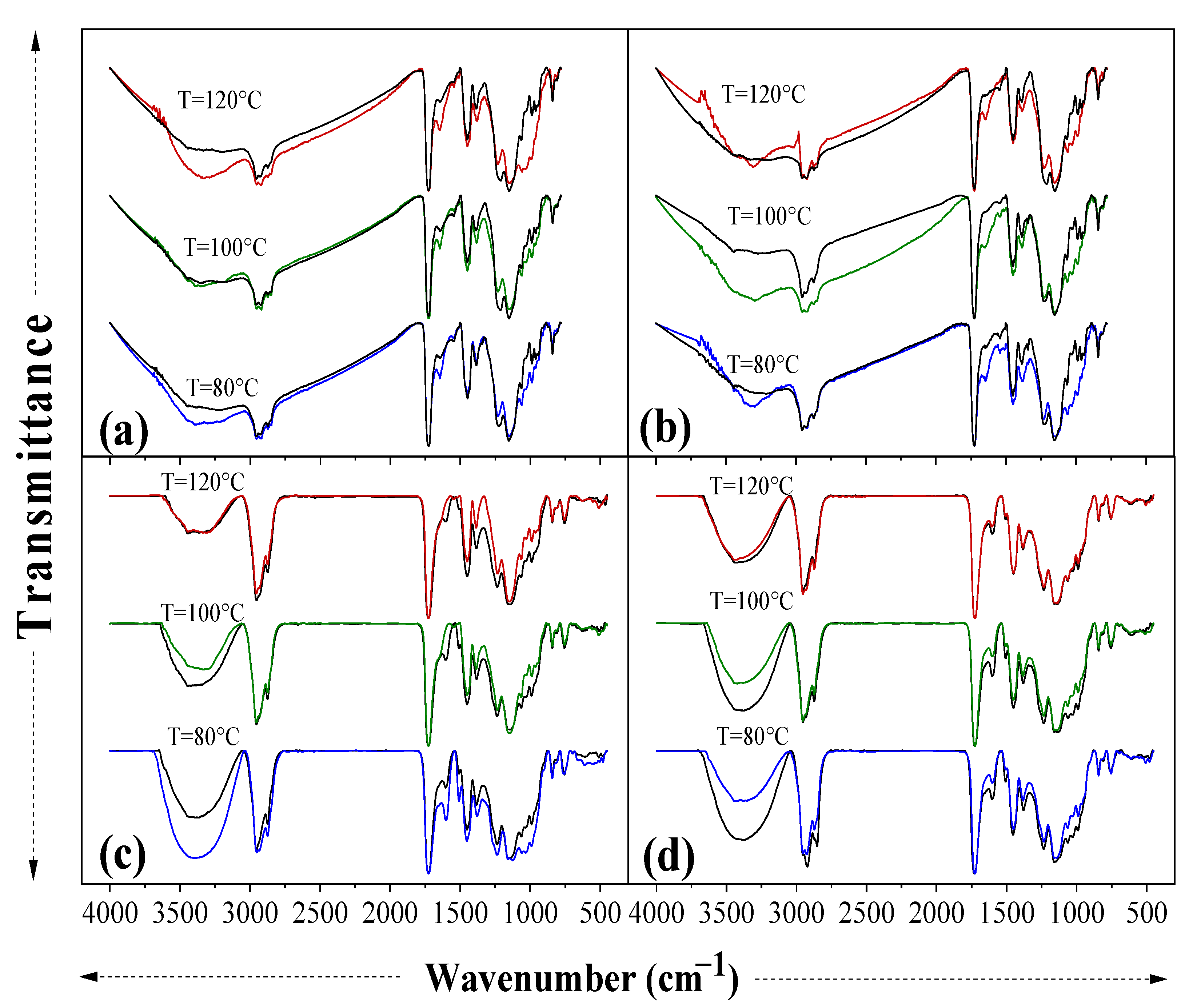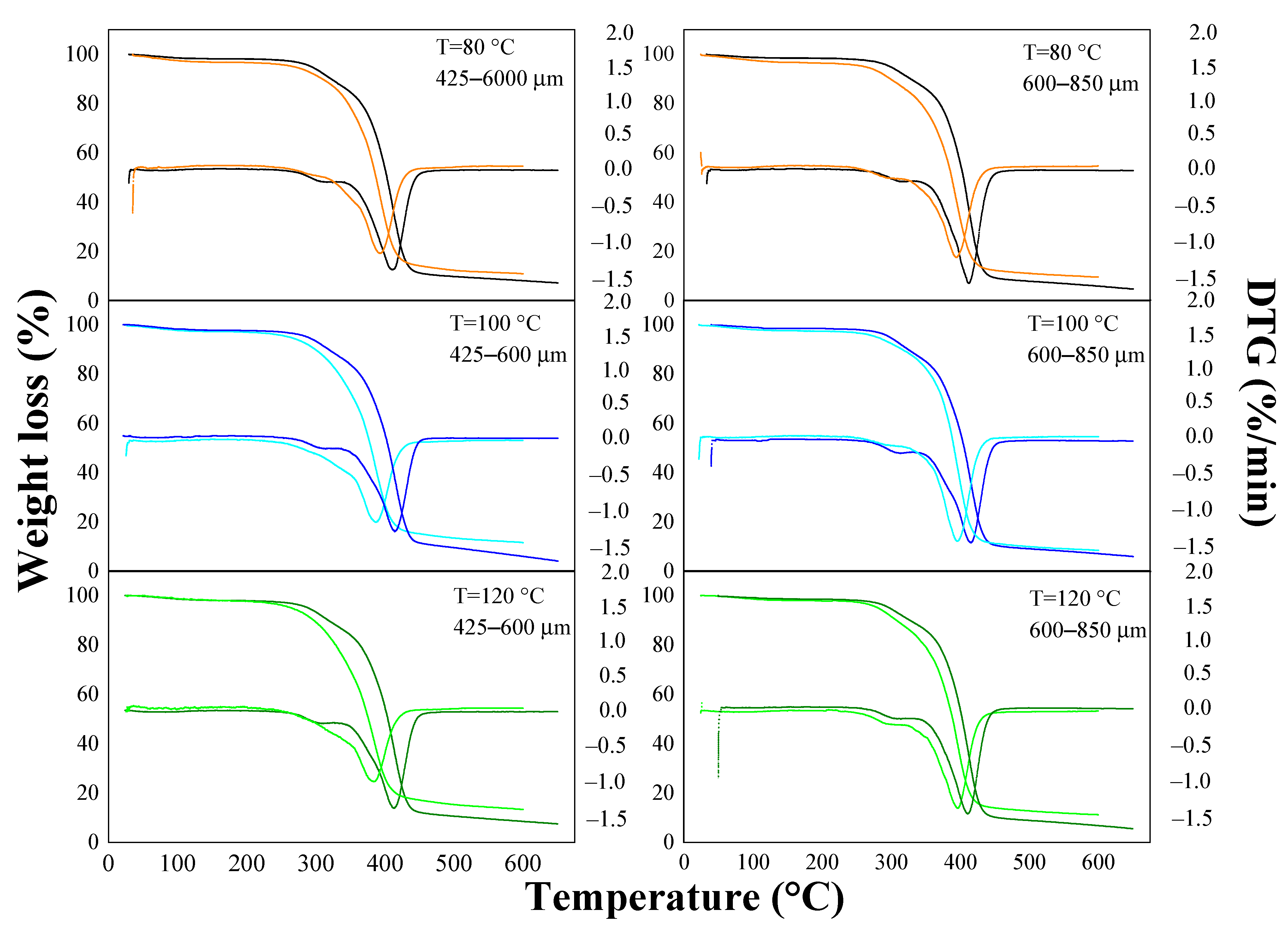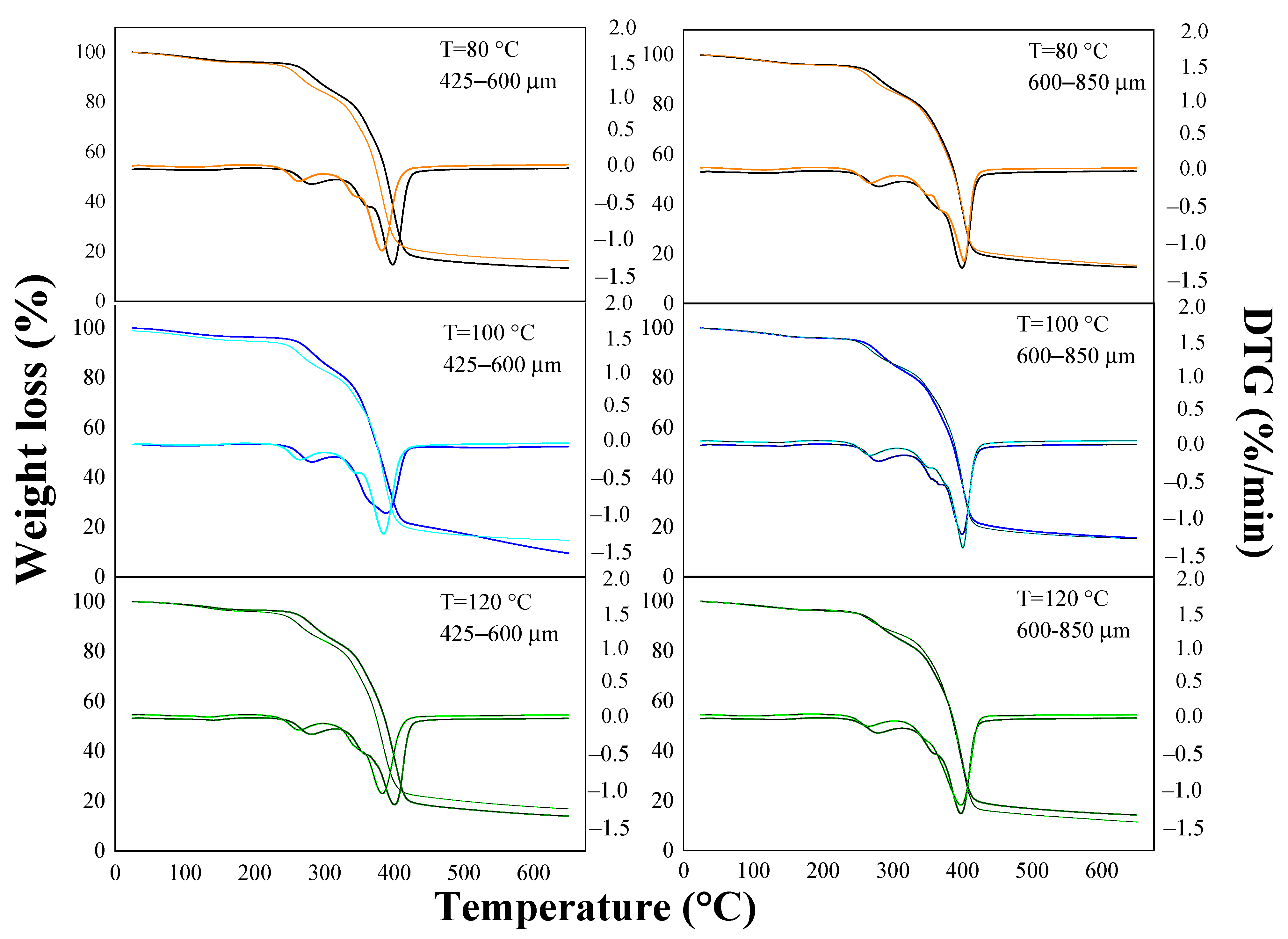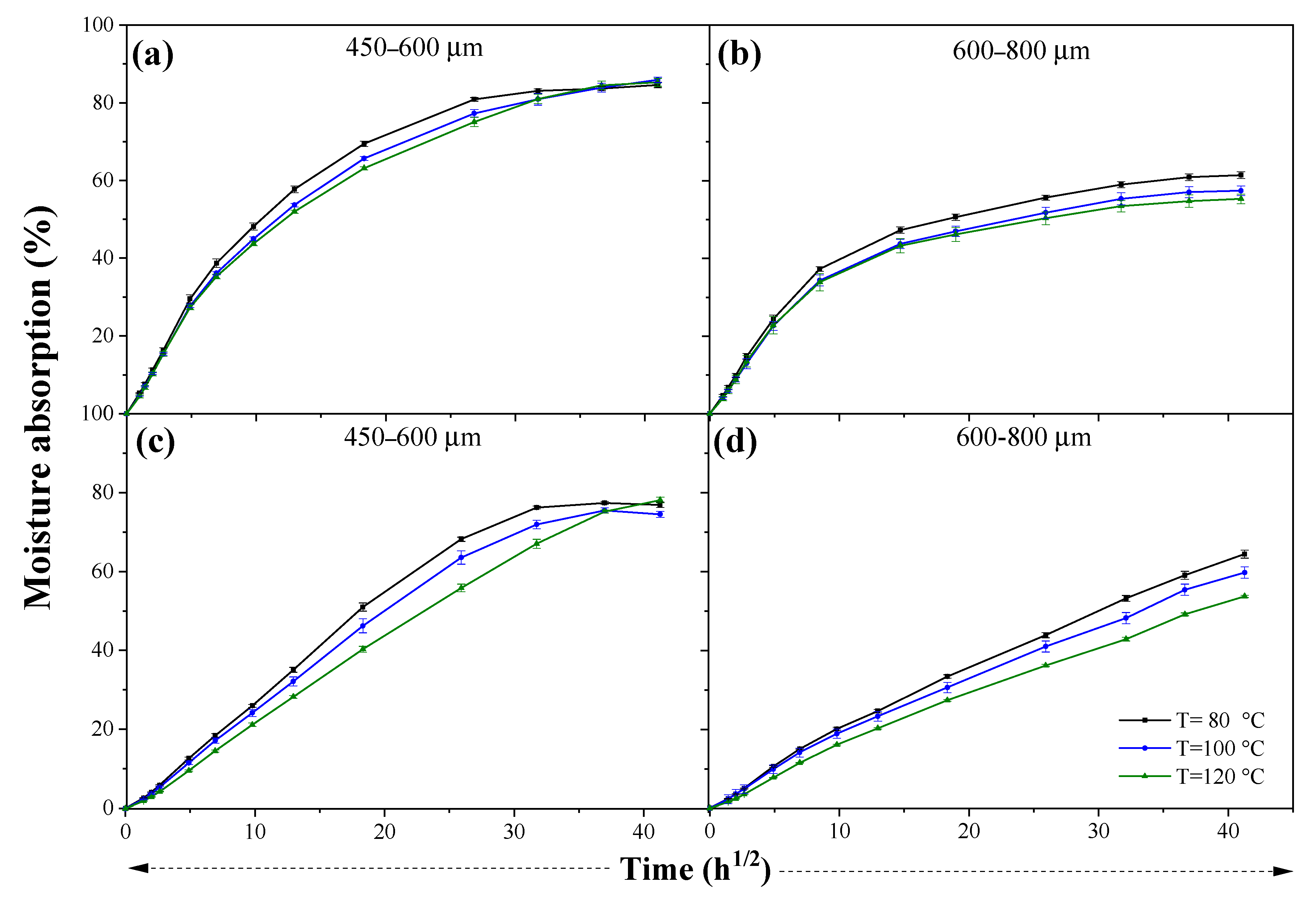Water Absorption Behavior of Oil Palm Empty Fruit Bunch (OPEFB) and Oil Palm Kernel Shell (OPKS) as Fillers in Acrylic Thermoplastic Composites
Abstract
:1. Introduction
2. Materials and Methods
2.1. Materials
2.2. Preparation of Composites
2.3. Material Characterization
2.4. Absorption Assays
3. Results and Discussion
3.1. Material Characterization
3.1.1. Reinforcement Characterization
3.1.2. Composite Characterization
3.2. Absorption Assays
4. Conclusions
Author Contributions
Funding
Institutional Review Board Statement
Informed Consent Statement
Data Availability Statement
Acknowledgments
Conflicts of Interest
References
- Sanjay, M.R.; Arpitha, G.R.; Naik, L.L.; Gopalakrishna, K.; Yogesha, B. Applications of Natural Fibers and Its Composites: An Overview. Nat. Resour. 2016, 7, 108–114. [Google Scholar] [CrossRef] [Green Version]
- Awais, H.; Nawab, Y.; Amjad, A.; Anjang, A.; Akil, H.; Zainol Abidin, M.S. Environmental benign natural fibre reinforced thermoplastic composites: A review. Compos. Part C Open Access 2021, 4, 100082. [Google Scholar] [CrossRef]
- Karimah, A.; Rasyidur, M.; Sofyan, S.; Sudarwoko, D. A review on natural fibers for development of eco-friendly bio-composite: Characteristics, and utilizations. J. Mater. Res. Technol. 2021, 13, 2442–2458. [Google Scholar] [CrossRef]
- Sanjay, M.; Siengchin, S.; Parameswaranpillai, J.; Jawaid, M.; Pruncu, C.I.; Khan, A. A Comprehensive Review of Techniques for Natural Fibers as Reinforcement in Composites: Preparation, Processing and Characterization. Carbohydr. Polym. 2019, 207, 108–121. [Google Scholar] [CrossRef]
- Verma, D.; Senal, I. Natural fiber-reinforced polymer composites: Feasibiliy study for sustainable automotive industries. In Biomass, Biopolymer-Based Materials, and Bioenergy; Elsevier Ltd.: Amsterdam, The Netherlands, 2019; pp. 103–122. ISBN 9780081024263. [Google Scholar]
- Keya, K.N.; Kona, N.A.; Koly, F.A. Natural fiber reinforced polymer composites: History, types, advantages and applications. Mater. Eng. Res. 2019, 1, 69–85. [Google Scholar] [CrossRef] [Green Version]
- Chauhan, V.; Kärki, T.; Varis, J. Review of natural fiber-reinforced engineering plastic composites, their applications in the transportation sector and processing techniques. J. Thermoplast. Compos. Mater. 2019. [Google Scholar] [CrossRef]
- Kufel, A.; Kuciel, S. Hybrid composites based on polypropylene with basalt/hazelnut shell fillers: The influence of temperature, thermal aging, and water absorption on mechanical properties. Polymers 2020, 12, 18. [Google Scholar] [CrossRef] [PubMed] [Green Version]
- Nordin, N.A.; Abd Rahman, N.M.M.; Hassan, A. Thermal and mechanical properties of injection moulded heat-treated oil palm empty fruit bunch fibre-reinforced high-density polyethylene composites. Plast. Rubber Compos. 2019, 48, 410–421. [Google Scholar] [CrossRef]
- Repositorio Digital de la Comisión Económica para América Latina y el Caribe; Santiago. 2017. Available online: https://repositorio.cepal.org/handle/11362/41830 (accessed on 17 May 2022).
- Chang, S.H. An overview of empty fruit bunch from oil palm as feedstock for bio-oil production. Biomass Bioenergy 2014, 62, 174–181. [Google Scholar] [CrossRef]
- Sharma, A.K.; Bhandari, R.; Aherwar, A. Matrix materials used in composites: A comprehensive study. Mater. Today Proc. 2020, 21, 1559–1562. [Google Scholar] [CrossRef]
- Saba, N.; Jawaid, M.; Sultan, M.T.H. Thermal Properties of Oil Palm Biomass Based Composites; Elsevier Ltd.: Amsterdam, The Netherlands, 2017; Volume 1, ISBN 9780081009666. [Google Scholar]
- Alfatah, T.; Mistar, E.M.; Syabriyana, M.; Supardan, M.D. Advances in oil palm shell fibre reinforced thermoplastic and thermoset polymer composites. Alexandria Eng. J. 2022, 61, 4945–4962. [Google Scholar] [CrossRef]
- Bakri, M.K.B.; Jayamani, E.; Heng, S.K.; Hamdan, S. Reinforced Oil Palm Fiber Epoxy Composites: An Investigation on Chemical Treatment of Fibers on Acoustical, Morphological, Mechanical and Spectral Properties. Mater. Today Proc. 2015, 2, 2747–2756. [Google Scholar] [CrossRef]
- Sreekala, M.S.; George, J.; Kumaran, M.G.; Thomas, S. The mechanical performance of hybrid phenol-formaldehyde-based composites reinforced with glass and oil palm fibres. Compos. Sci. Technol. 2002, 62, 339–353. [Google Scholar] [CrossRef]
- Ahmad, F.; Choi, H.S.; Park, M.K. A Review: Natural Fiber Composites Selection in View of Mechanical, Light Weight, and Economic Properties. Macromol. Mater. Eng. 2015, 300, 10–24. [Google Scholar] [CrossRef]
- Jariwala, H.; Jain, P. A review on mechanical behavior of natural fiber reinforced polymer composites and its applications. J. Reinf. Plast. Compos. 2019, 8, 441–453. [Google Scholar] [CrossRef]
- Obande, W.; Ó Brádaigh, C.M.; Ray, D. Continuous fibre-reinforced thermoplastic acrylic-matrix composites prepared by liquid resin infusion—A review. Compos. Part B Eng. 2021, 215, 108771. [Google Scholar] [CrossRef]
- Kinvi-Dossou, G.; Matadi Boumbimba, R.; Bonfoh, N.; Garzon-Hernandez, S.; Garcia-Gonzalez, D.; Gerard, P.; Arias, A. Innovative acrylic thermoplastic composites versus conventional composites: Improving the impact performances. Compos. Struct. 2019, 217, 1–13. [Google Scholar] [CrossRef]
- Balogun, O.P.; Adediran, A.A.; Omotoyinbo, J.A.; Alaneme, K.K.; Oladele, I.O. Evaluation of Water Diffusion Mechanism on Mechanical Properties of Polypropylene Composites. Int. J. Polym. Sci. 2020, 2020, 8865748. [Google Scholar] [CrossRef]
- Mrad, H.; Alix, S.; Migneault, S.; Koubaa, A.; Perré, P. Numerical and experimental assessment of water absorption of wood-polymer composites. Measurement 2018, 115, 197–203. [Google Scholar] [CrossRef]
- Ramlee, N.A.; Mohammad, J.; Zainudin, S.E.; Karim Yamani, A.S. Tensile, physical and morphological properties of oil palm empty fruit bunch/sugarcane bagasse fibre reinforced phenolic hybrid composites. J. Mater. Res. Technol. 2019, 8, 3466–3474. [Google Scholar] [CrossRef]
- Moudood, A.; Rahman, A.; Öchsner, A.; Islam, M.; Francucci, G. Flax fiber and its composites: An overview of water and moisture absorption impact on their performance. J. Reinf. Plast. Compos. 2018, 38, 323–339. [Google Scholar] [CrossRef] [Green Version]
- Maslinda, A.B.; Majid, M.S.A.; Ridzuan, M.J.M.; Afendi, M.; Gibson, A.G. Effect of water absorption on the mechanical properties of hybrid interwoven cellulosic-cellulosic fibre reinforced epoxy composites. Compos. Struct. 2017, 167, 227–237. [Google Scholar] [CrossRef]
- Nabinejad, O.; Sujan, D.; Rahman, M.E.; Davies, I.J. Effect of oil palm shell powder on the mechanical performance and thermal stability of polyester composites. Mater. Des. (1980–2015) 2015, 65, 823–830. [Google Scholar] [CrossRef]
- Ayu, R.S.; Khalina, A.; Harmaen, A.S.; Zaman, K.; Isma, T.; Liu, Q.; Ilyas, R.A.; Lee, C.H. Characterization Study of Empty Fruit Bunch (EFB) Fibers Reinforcement in Poly(Butylene) Succinate (PBS)/Starch/Glycerol Composite Sheet. Polymers 2020, 12, 1571. [Google Scholar] [CrossRef] [PubMed]
- Sahari, J.; Maleque, M.A. Mechanical Properties of Oil Palm Shell Composites. Int. J. Polym. Sci. 2016, 2016, 7457506. [Google Scholar] [CrossRef]
- Shehu, U.; Aponbiede, O.; Ause, T.; Obiodunukwe, E.F. Effect of particle size on the properties of Polyester/Palm Kernel Shell (PKS) Particulate Composites. J. Mater. Environ. Sci. 2014, 5, 366–373. [Google Scholar]
- Valle, V.; Aguilar, A.; Kreiker, J.; Raggiotti, B.; Cadena, F. Oil Palm Empty Fruit Bunch (OPEFB) Fiber-Reinforced Acrylic Thermoplastic Composites: Effect of Salt Fog Aging on Tensile, Spectrophotometric, and Thermogravimetric Properties. Int. J. Polym. Sci. 2022, 2022, 6372264. [Google Scholar] [CrossRef]
- Tan, T.; Zhou, J.; Gao, X.; Tang, X.; Zhang, H. Synthesis, characterization and water-absorption behavior of tartaric acid-modified cellulose gel fromcorn stalk pith. Ind. Crop. Prod. 2021, 169, 113641. [Google Scholar] [CrossRef]
- Vilay, V.; Mariatti, M.; Mat Taib, R.; Todo, M. Effect of fiber surface treatment and fiber loading on the properties of bagasse fiber-reinforced unsaturated polyester composites. Compos. Sci. Technol. 2008, 68, 631–638. [Google Scholar] [CrossRef]
- Ramakrishnan, S.; Krishnamurthy, K.; Rajasekar, R.; Rajeshkumar, G. An experimental study on the effect of nano-clay addition on mechanical and water absorption behaviour of jute fibre reinforced epoxy composites. J. Ind. Text. 2019, 49, 597–620. [Google Scholar] [CrossRef]
- Arif, M.; Supian, F.; Najwa, K.; Amin, M.; Jamari, S.S.; Mohamad, S. Production of cellulose nanofiber (CNF) from empty fruit bunch (EFB) via mechanical method. Environ. Chem. Eng. 2019, 8, 103024. [Google Scholar] [CrossRef]
- Phreecha, N.; Chinpa, W. Environmentally Friendly Composites from Seabass Scale and Oil Palm Empty Fruit Bunch Waste. J. Polym. Environ. 2019, 27, 1043–1053. [Google Scholar] [CrossRef]
- Dhakal, H.N.; Zhang, Z.Y.; Bennett, N.; Lopez-Arraiza, A.; Vallejo, F.J. Effects of water immersion ageing on the mechanical properties of flax and jute fibre biocomposites evaluated by nanoindentation and flexural testing. J. Compos. Mater. 2014, 48, 1399–1406. [Google Scholar] [CrossRef] [Green Version]
- Ranakoti, L.; Pokhriyal, M.; Kumar, A. Natural fibers and biopolymers characterization: A future potential composite material. J. Mech. Eng. 2018, 68, 33–50. [Google Scholar] [CrossRef] [Green Version]
- Okoroigwe, E.C.; Saffron, C.M.; Kamdem, P. Characterization of palm kernel shell for materials reinforcement and water treatment. J. Chem. Eng. Mater. Sci. 2014, 5, 1–6. [Google Scholar] [CrossRef] [Green Version]
- Célino, A.; Gonçalves, O.; Jacquemin, F.; Fréour, S. Qualitative and quantitative assessment of water sorption in natural fibres using ATR-FTIR spectroscopy. Carbohydr. Polym. 2014, 101, 163–170. [Google Scholar] [CrossRef] [Green Version]
- Geng, W.; Venditti, R.A.; Pawlak, J.J.; Pal, L.; Ford, E. Carboxymethylation of hemicellulose isolated from poplar (Populus grandidentata) and its potential in water-soluble oxygen barrier films. Cellulose 2020, 27, 3359–3377. [Google Scholar] [CrossRef]
- Morales, A.; Labidi, J.; Gullón, P. Effect of the formulation parameters on the absorption capacity of smart lignin-hydrogels. Eur. Polym. J. 2020, 129, 109631. [Google Scholar] [CrossRef]
- Stalin, B.; Nagaprasad, N.; Vignesh, V.; Ravichandran, M.; Rajini, N.; Ismail, S.O.; Mohammad, F. Evaluation of mechanical, thermal and water absorption behaviors of Polyalthia longifolia seed reinforced vinyl ester composites. Carbohydr. Polym. 2020, 248, 116748. [Google Scholar] [CrossRef]
- Ike-eze, I.C.E.; Uyor, U.O. Characteristics of Palm Kernel Shell and Palm Kernel Shell-Polymer Composites: A Review. IOP Conf. Ser. Mater. Sci. Eng. 2021, 1107, 012090. [Google Scholar] [CrossRef]
- Al-maharma, A.Y. Critical Review of the Parameters Affecting the Effectiveness of Moisture Absorption Treatments Used for Natural Composites. J. Compos. Sci. 2019, 3, 27. [Google Scholar] [CrossRef] [Green Version]
- Abdul Khalil, H.P.S.; Siti Alwani, M.; Ridzuan, R.; Kamarudin, H.; Khairul, A. Chemical Composition, Morphological Characteristics, and Cell Wall Structure of Malaysian Oil Palm Fibers. Polym. Plast. Technol. Eng. 2015, 2015, 37–41. [Google Scholar] [CrossRef]
- Xiao, B.; Wang, W.; Zhang, X.; Long, G.; Fan, J.; Chen, H.; Deng, L. A novel fractal solution for permeability and Kozeny-Carman constant of fibrous porous media made up of solid particles and porous fibers. Powder Technol. 2019, 349, 92–98. [Google Scholar] [CrossRef]
- Liang, M.; Fu, C.; Xiao, B.; Luo, L.; Wang, Z. A fractal study for the effective electrolyte diffusion through charged porous media. Int. J. Heat Mass Transf. 2019, 137, 365–371. [Google Scholar] [CrossRef]
- Ardebili, H.; Zhang, J.; Pecht, M.G. Characterization of encapsulant properties. In Encapsulation Technologies for Electronic Applications; no. 1; Elsevier Science: Amsterdam, The Netherlands, 2019; pp. 221–258. [Google Scholar]





| Parameter | OPEFB | OPKS |
|---|---|---|
| Shape |  |  |
| Fibers | Particles | |
| Lignin (%) | 19.12 ± 0.42 | 48.94 ± 0.51 |
| Cellulose (%) | 49.63 ± 0.64 | 24.96 ± 0.60 |
| Hemicellulose (%) | 21.32 ± 0.50 | 23.12 ± 0.20 |
| Extractives (%) | 1.46 ± 0.09 | 2.97 ± 0.11 |
| * Moisture (%) | 7.60 ± 0.47 | 8.80 ± 0.75 |
| Ashes (%) | 6.23 ± 0.19 | 8.69 ± 0.01 |
| Filler | Particle Size (µm) | Processing Temperature (°C) | Constants for Fick Model | Transport Coefficient | |||||
|---|---|---|---|---|---|---|---|---|---|
| Swelling Exponent (n) | Characteristic Constant (k) | R2 | χ2 × 10−3 | D × 10−9 (m2/min) | S (g/g) | P × 10−9 (m2/min) | |||
| OPEFB | 425–600 | 80 | 0.270 | 0.151 | 0.963 | 6.00 | 15.332 | 0.454 | 6.959 |
| 100 | 0.285 | 0.136 | 0.976 | 4.06 | 11.692 | 0.447 | 5.231 | ||
| 120 | 0.290 | 0.127 | 0.980 | 3.11 | 10.175 | 0.448 | 4.555 | ||
| 600–850 | 80 | 0.249 | 0.175 | 0.961 | 6.64 | 8.583 | 0.371 | 3.182 | |
| 100 | 0.254 | 0.169 | 0.961 | 6.66 | 7.638 | 0.356 | 2.719 | ||
| 120 | 0.246 | 0.179 | 0.957 | 7.41 | 7.532 | 0.348 | 2.622 | ||
| OPKS | 425–600 | 80 | 0.394 | 0.060 | 0.975 | 4.52 | 7.196 | 0.433 | 3.113 |
| 100 | 0.410 | 0.053 | 0.981 | 3.34 | 6.852 | 0.418 | 2.868 | ||
| 120 | 0.465 | 0.034 | 0.995 | 0.77 | 5.544 | 0.401 | 2.226 | ||
| 600–850 | 80 | 0.424 | 0.047 | 0.998 | 0.24 | 6.106 | 0.347 | 2.120 | |
| 100 | 0.420 | 0.046 | 0.999 | 0.18 | 5.041 | 0.325 | 1.639 | ||
| 120 | 0.440 | 0.040 | 0.998 | 0.27 | 5.138 | 0.300 | 1.541 | ||
| Filler | Particle Size (µm) | Processing Temperature (°C) | Thickness Swelling (%) |
|---|---|---|---|
| OPEFB | 425–600 | 80 | 15.93 ± 2.19 |
| 100 | 22.66 ± 3.04 | ||
| 120 | 17.14 ± 2.25 | ||
| 600–850 | 80 | 29.08 ± 1.37 | |
| 100 | 22.10 ± 2.01 | ||
| 120 | 19.73 ± 1.00 | ||
| OPKS | 425–600 | 80 | 54.08 ± 6.25 |
| 100 | 37.68 ± 2.64 | ||
| 120 | 31.87 ± 1.25 | ||
| 600–850 | 80 | 81.39 ± 4.97 | |
| 100 | 58.19 ± 6.11 | ||
| 120 | 39.29 ± 2.73 |
Publisher’s Note: MDPI stays neutral with regard to jurisdictional claims in published maps and institutional affiliations. |
© 2022 by the authors. Licensee MDPI, Basel, Switzerland. This article is an open access article distributed under the terms and conditions of the Creative Commons Attribution (CC BY) license (https://creativecommons.org/licenses/by/4.0/).
Share and Cite
Almeida-Naranjo, C.E.; Valle, V.; Aguilar, A.; Cadena, F.; Kreiker, J.; Raggiotti, B. Water Absorption Behavior of Oil Palm Empty Fruit Bunch (OPEFB) and Oil Palm Kernel Shell (OPKS) as Fillers in Acrylic Thermoplastic Composites. Materials 2022, 15, 5015. https://doi.org/10.3390/ma15145015
Almeida-Naranjo CE, Valle V, Aguilar A, Cadena F, Kreiker J, Raggiotti B. Water Absorption Behavior of Oil Palm Empty Fruit Bunch (OPEFB) and Oil Palm Kernel Shell (OPKS) as Fillers in Acrylic Thermoplastic Composites. Materials. 2022; 15(14):5015. https://doi.org/10.3390/ma15145015
Chicago/Turabian StyleAlmeida-Naranjo, Cristina E., Vladimir Valle, Alex Aguilar, Francisco Cadena, Jeronimo Kreiker, and Belén Raggiotti. 2022. "Water Absorption Behavior of Oil Palm Empty Fruit Bunch (OPEFB) and Oil Palm Kernel Shell (OPKS) as Fillers in Acrylic Thermoplastic Composites" Materials 15, no. 14: 5015. https://doi.org/10.3390/ma15145015
APA StyleAlmeida-Naranjo, C. E., Valle, V., Aguilar, A., Cadena, F., Kreiker, J., & Raggiotti, B. (2022). Water Absorption Behavior of Oil Palm Empty Fruit Bunch (OPEFB) and Oil Palm Kernel Shell (OPKS) as Fillers in Acrylic Thermoplastic Composites. Materials, 15(14), 5015. https://doi.org/10.3390/ma15145015







